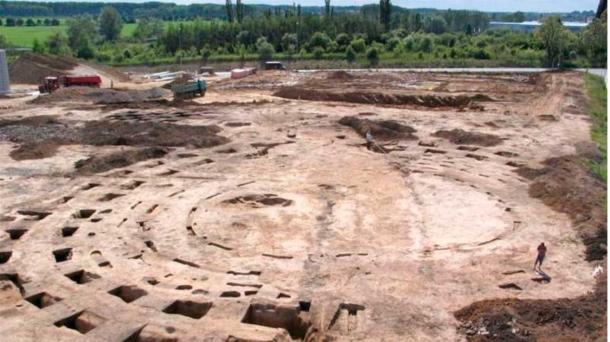A stunning Neolithic roundel structure that is older than Stonehenge has been announced by Czech Republic archaeologists. The remains of this mysterious roundel structure have been dated to approximately 7,000 years old. The purpose of these roundel structures still elude experts.
Roundels are believed to be ‘’the oldest evidence of architecture in all of Europe” according to Jaroslav Řídký of the Institute of Archaeology of the Czech Academy of Sciences. So far 200 roundels have been found across Europe, 35 of them in the Czech Republic.
This latest Neolithic roundel structure, found in the Vinoř district of Prague, has an unusual floor plan with three separate entrances. Part of the structure was revealed back in the 1980s, but now almost 40 years later, the entire structure has been uncovered.

An aerial view of the Neolithic roundel structure found on the outskirts of Prague. ( Institute of Archaeology of the Czech Academy of Sciences )
Neolithic Roundel Structures: A Polytheist Architectural Style
The Prague Neolithic roundel structure was likely constructed between 4900 and 4600 BC. For comparison, Stonehenge was constructed in 3100 BC, and the Giza pyramids around 2600 BC. This suggests the Prague Neolithic roundel structure was built by the Stroked Pottery culture, renowned for their farming villages in Central Europe. This culture reached its peak between 4900 and 4400 BC.
- 8,000-Year-Old Neolithic Temple Discovered in Saudi Arabia
- Where Death Rings in the Hour: The Amazing Medieval Astronomical Clock of Prague
The Prague roundel structure is immaculately preserved. And the palisade troughs into which the central wooden structure was originally embedded are all intact, reported Radio Prague International . The purpose of this massive structure, which is 180 feet (55 meters) in diameter, about as tall as the Leaning Tower of Pisa, is yet unknown. The large site also yielded numerous pottery fragments, animal bones , and stone tools, which were found in the ditch fill.
Miroslav Kraus, the director of this research said, “One such theory is that it could have been used as an economic center, a center of trade. It could also have been a center of some religious cult , where rites of passage or rituals connected to the time of year were performed. Roundels were built during the Stone Age, when people had not yet discovered iron. The only tools they could use were made of stone and animal bones.”
The Stroked Pottery culture was renowned for its roundels across the Bohemian region of the Czech Republic. They lived in sedentary farming villages at the intersection of modern-day Poland, eastern Germany and northern Czech Republic, reported Live Science .
These early Neolithic settlements consisted of several longhouses, which were large, rectangular structures that could accommodate between 20 and 30 individuals. Roundel construction knowledge was possessed by different areas across Europe, but all were built within 200-300 years of each other.

The overall layout of the 7,000-year-old Neolithic roundel structure found near Prague. ( Institute of Archaeology of the Czech Academy of Sciences )
Early Roundels: General Structure and Function
With drone and aerial photography becoming ever prevalent in the archaeology scene, more and more roundels have been discovered across Europe. When seen from above, a roundel consists of one or more wide, circular ditches. The roundel interior was lined with wooden poles and mud plaster.
The first European roundel, Goseck Circle , was discovered in Germany in 1991. It measured 246 feet (75 meters) in diameter and featured a double wooden palisade with three entrances. The entrances are believed to correspond with the summer and winter solstice, functioning perhaps as an observatory or calendar of some kind.
Roundels were built for large gatherings related to daily life, communal events, and death rituals. They could have also functioned as military outposts to guard a nearby settlement. Clearly, these ancient structures had a socio-ritual function.
“It would be great to discover something that would indicate the actual function of the building. However, it is very unlikely, since none of the previously researched roundels had revealed such information. It would also be great to find something that would suggest its real age. So far, radiocarbon dating of samples collected from roundels has put their age somewhere between 4900 years to 4600 BC. That is a pretty wide time span,” concluded Kraus.
- Artist Reconstructs Faces of Slavic Warriors Who Survived Nazi Attack
- Speculum Alchemiae: Secret Underground Alchemy Lab Discovered in Prague During Flood
The Vinor Neolithic roundel structure work will continue until October and will mostly focus on a Neolithic settlement that had been in use for 300-400 years, found northeast of the roundel.
The discovery of 7,000-year-old structures in Europe is rare and the latest Neolithic roundel structure near Prague will undoubtedly shed new light on earliest settlements in the region.
Top image: An artist’s depiction of what the 7,000-year-old Neolithic roundel structure found near Prague would have looked like. Source: Institute of Archaeology of the Czech Academy of Sciences
By Sahir Pandey





